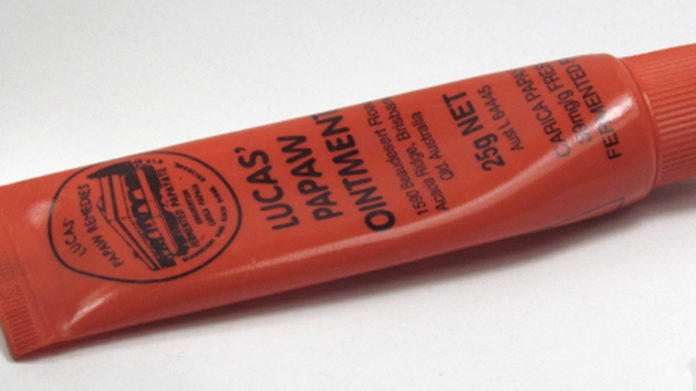You’re probably using Lucas’ Papaw ointment the wrong way

The red tube filled with Lucas’ Papaw ointment is a cult product used by Australians — but some people are claiming it is just expensive Vaseline.
At around A$5 a pop, the tube of ointment is being obsessively slapped on dry lips across the country. The company said although the ointment is definitely not a moisturiser, it does have healing qualities that can help chapped lips.
Despite the public’s infatuation with this little tube, many blog posts have been written claiming they expose the truth of what is inside the product — despite the ingredients being displayed prominently on the tube and the company’s website. It is made from papaw fruit, petroleum jelly and a small amount of gum balsam of Peru for scent.
But with only 4% worth of papaw, a make-up artist from Melbourne, Wanda Waller, claims Lucas’ Papaw is basically petroleum jelly and is bad for you. She wrote a post on Facebook on July 23, explaining why she would never use the ointment on herself or her clients.
“I don’t know any other Australian product that has such a cult following than famous red tubed Lucas’ PaPaw ointment. Unfortunately, [at] the end of the day it is basically a repackaged more expensive version of Vaseline,” Waller wrote. “Lucas’ PaPaw contains more petroleum jelly than an actual pawpaw.”
She details that the ointment contains 39 milligrams per gram of fermented papaw, and as there are 1000 milligrams in a gram, this means the product is 96% petroleum jelly and 4% papaw.
°The reason why I would never use Lucas’ PaPaw on my clients or myself°I don’t know any other Australian product that…
Posted by Wanda Waller – Makeup Artist on Wednesday, July 22, 2015
The company has always been very clear about its ingredients, listing them on the package and their website. “The many testimonials by people who have used Lucas’ Papaw Ointment over the last 105 years show how effective it is, and that it is not just ‘a tube of petroleum jelly’,” Lucas’ Papaw spokesperson Karyn Lees told Mashable Australia in response to the criticism.
The active ingredient is created by using a fermentation process to concentrate the enzymes from Australian papaws, rather than using a processed papaw powder from overseas.
“[This] means we must use a smaller proportion of active ingredient than the other products that use processed unfermented extracts from papaws,” Lees said. “The healing properties of fresh fermented papaw is very potent and has to be carefully balanced or it will be too strong for human use … and effectively “burn” our skin.”
The company still uses the recipe for the ointment that was created more than 100 years ago. “The formulation of these simple ingredients is a very tightly held family treasure as you can imagine,” she added. The papaw is used to draw out impurities and has antiseptic qualities, while the petroleum jelly helps to heal, Lees explained.
The moisture debate
In their haste to stay on trend, some Aussies are perhaps failing to read the fine print. Responses to Waller’s Facebook post were variations of shock, praise and all-out devastation.

Image: Facebook / Wanda Waller
Waller also claims that petroleum jelly isn’t very good for you. The company says it only uses pharmaceutical-grade petroleum jelly that is strictly certified to ensure its safety and quality.
“Petroleum jelly (petrolatum, mineral oil, liquid paraffin or paraffin oil) is a by-product of the oil industry, coming from crude oil that has been refined and heavily processed,” Waller wrote on Facebook.
Lees said the fear-mongering around petroleum jelly is due to misinformation and confusion. “It was brought into question at one stage in its history as the market was flooded with a poorly refined and cheaply produced low quality version,” Lees said. “The pharmaceutical grade petroleum jelly used in Lucas’ Papaw Ointment is further filtered and highly clarified to ensure that there are no carcinogens or impurities.”
Waller also claimed Lucas’ Pawpaw ointment clogs the pores and slows the elimination of toxins from the skin. “It is the cheapest way you can make a moisturizer, one that feels amazing on the skin but it actually not that good for you. Petroleum jelly creates a physical barrier against the skin, meaning moisture can’t get in or out,” Waller wrote.
So how should it be used
But the ointment is not meant to be used as a moisturiser, Lees told Mashable Australia however it can help retain moisture and heal cracked lips, shocking the red-tube lip-smacking population.
“Lucas’ Papaw Ointment is ideal for lips if you want to help heal or sooth inflamed, chapped or broken skin,” Lees said. “Over more recent years it has become popular to use Lucas’ Papaw Ointment as a lip gloss. While this type of use will definitely not harm anyone and can give the feeling of moisture, this cosmetic use for beauty outcomes is not something we get involved in as we focus entirely on the healing qualities.”

Image: The Luxe List
The company does not promote its use as a lip gloss or as adding moisture. “It does help the body maintain its existing moisture due to the qualities of petroleum jelly, and does not dry out your skin,” Lees said. “Science shows that petroleum jelly does not clog the pores as claimed on the Facebook post, even though it has this moisture retention capability.”
The ointment was developed in Brisbane, Australia in 1910 by Dr Thomas Lucas, a botanist and medical practitioner, who believed pap paw was the finest natural medicine ever discovered.
Although it can help heal your wounds, if you are looking for added moisture for your lips, you’re best bet is to use a moisturiser.
Have something to add to this story? Share it in the comments.
